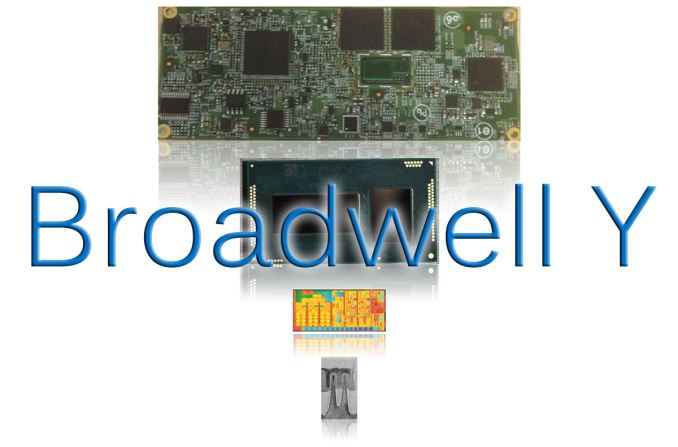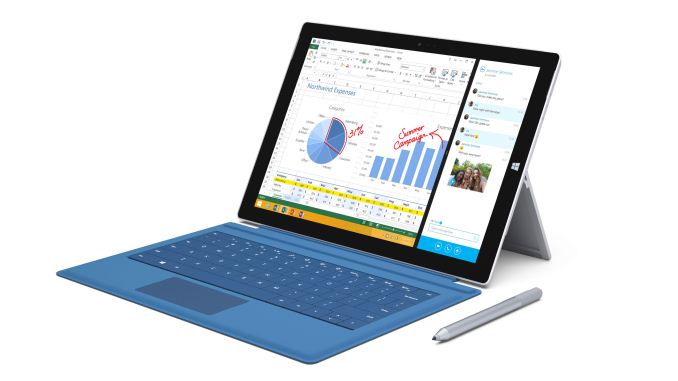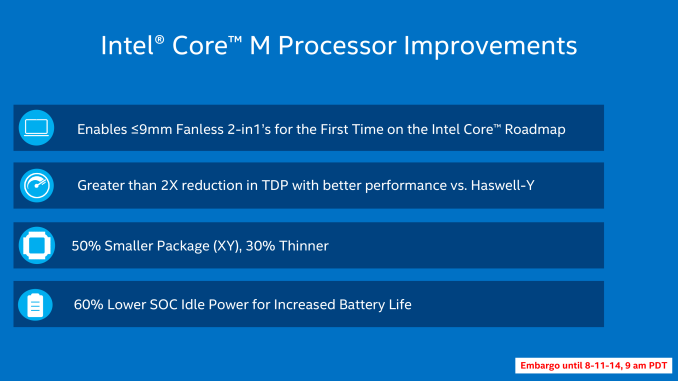Short Bytes: Intel's Core M and Broadwell-Y SoC
by Jarred Walton on August 12, 2014 6:00 AM EST- Posted in
- Short Bytes
- CPUs
- Intel
- Mobile
- Laptops
- Tablets
- Broadwell
- Core M
- Broadwell-Y

Intel has slowly been feeding us information about their upcoming Broadwell processors for a couple years now, with the first real details kicking off almost a year ago at IDF 2013. Since then, the only other noteworthy piece of information came back in March when it was revealed that socketed Broadwell CPUs with unlocked multipliers will be available with Iris Pro Graphics. Today, Intel is ready to begin providing additional information, and it starts with the Broadwell-Y processor, which Intel is now referring to as an SoC (System On Chip). We have an in-depth article on the subject, but for Short Bytes we want to focus on the bottom line: what does this mean for end users?
The big news for Broadwell is that it will be the first 14nm processor available to the public, following on the success of Intel's 22nm process technology. Shrinking the process technology from 22nm to 14nm can mean a lot of things, but the primary benefit this time appears to be smaller chip sizes and lower power requirements. The first parts will belong to the Core M family of products, a new line catering specifically to low power, high mobility form factors (typically tablets and hybrid devices). With Core M, Intel has their sights set on the fanless computing market with sub-9mm thick designs, and they have focused on reducing power requirements in order to meet the needs of this market. This brings us to Broadwell-Y, the lowest power version of Broadwell and the successor to Haswell-Y and the codename behind the new Core M.
The reality of Intel's Y-series of processors is that they haven't been used all that much to date. Only a handful of devices used Haswell-Y (and even fewer used Ivy Bridge-Y), mostly consisting of 2-in-1 devices that can function as both a laptop and a tablet. For example, the base model Surface Pro 3 uses a Core i3-4020Y, and Dell's XPS 11 and certain Venue Pro 11 tablets also use Y-series parts; Acer, HP, Sony, and Toshiba also have some detachable hybrid devices with the extreme low power processors. Unfortunately, pricing on the Y-series is generally much higher than competiting solutions (i.e. ARM-based SoCs), and there have been criticisms of Intel's higher power requirements and lower overall battery life as well.
Core M thus serves marketing needs as well as technical requirements: it replaces the Core i3/i5/i7 Y-series parts and gives Intel a brand they can market directly at premium tablets/hybrids. And in another move likely driven by marketing, Core M will be the launch part for Intel's new 14nm process technology. Transitions between process technology usually come every 2-3 years, so the 14nm change is a big deal and launching with their extreme low power part makes a statement. The key message of Broadwell is clear: getting into lower power devices and improving battery life is a critical target. To that end, Broadwell-Y probably won't be going into any smartphones, but getting into more premium tablets and delivering better performance with at least competitive battery life relative to other SoCs is a primary goal.
Compared to the Haswell-Y parts, Intel has made some significant advances in performance as well as power use, which we've covered elsewhere. The cumulative effect of the improvements Intel is bringing is that Broadwell-Y has a greater than 2X reduction in TDP (Thermal Design Power) compared to Haswell-Y. It also has a 50% smaller and 30% thinner package and uses 60% lower idle power. Intel points out that Broadwell-Y is set to deliver more than a 2X improvement in performance per Watt over Haswell-Y, though that's a bit more of a nebulous statement (see below). Many of the improvements come thanks to Intel's increased focus on driving down power requirements. Where previous Intel processors targeted laptops and desktops as the primary use case and then refined and adjusted the designs to get into lower power envelopes, with Broadwell Intel is putting the Y-series requirements center stage. The term for this is "co-optimization" of the design process, and these co-optimizations for Broadwell-Y are what allows Intel to talk about "2x improvements". But you need to remember what is being compared: Haswell-Y and Broadwell-Y.
Broadwell parts in general will certainly be faster/better than the current Haswell parts – Intel doesn't typically "go backwards" on processor updates – but you shouldn't expect twice the performance at the same power. Instead, Broadwell-Y should offer better performance than Haswell-Y using much less power, but if you reduce total power use by 2X you could increase performance by 5% and still claim a doubling of performance per Watt. And that's basically what Intel is doing here. Intel estimates the core Broadwell architecture to be around 5% faster than Haswell at the same clocks; specifically, IPC (Instructions Per Cycle) are up ~5% on average. Similarly, changes and improvements to the graphics portion of the processor should deliver more performance at a lower power draw. Add in slightly higher clock speeds and you get a faster part than last generation that uses less power. These are all good improvements, but ultimately it comes down to the final user experience and the cost.
Everywhere you go, people are increasingly using tablets and smartphones for many of their daily computing needs, and being left out of that market is the road to irrelevance. Core M (Broadwell-Y) is Intel's latest push to make inroads into these extremely low power markets, and on paper it looks like Intel has a competitive part. It's now up to the device vendors to deliver compelling products, as fundamentally the choice of processor is only one element of an electronics device. Being the first company to deliver 14nm parts certainly gives Intel an edge over the competition, but high quality Android and iOS tablets sell for $300-$500, so there's not a lot of room for a $100+ processor – which is why Intel has their Atom processors (due for the 14nm treatment with Braswell, if you're wondering).
Core M is going after the premium tablet/hybird market, with benefits including full Windows 8 support, but will it be enough? If you're interested in such a device and you don't already own the Haswell-Y version, Core M products should deliver slimmer and lighter devices with improved battery life and better performance. Don't expect a 10" Core M tablet to deliver the same battery life as a 7" Android/iOS device (at least, not without a larger battery), since the display and other components contribute a lot to power use and Windows 8 has traditionally been far less battery friendly than Android; still, Core M tablets may finally match or perhaps even exceed the battery life of similarly sized iOS/Android tablets. The first retail products with Core M should be shipping before the end of the year, so we'll find out later this year and early next how well Broadwell-Y is able to meet its lofty goals. And we'll also find out how much the Core M products cost.












31 Comments
View All Comments
p1esk - Tuesday, August 12, 2014 - link
Broadwell design does not seem that much more complex than Haswell. It's just a few small tricks on top of existing architecture. I don't think the transistor count went up significantly.The reason behind delay is more likely to be a poor yield. They are pushing the lowest power chips first because that's where ARM is beating them in the battle for smartphones and tablets. Laptop/desktop market does not demand the same urgency to mass produce chips at low yield.
JarredWalton - Tuesday, August 12, 2014 - link
I think the most likely cause for the delay of Broadwell is that there's a huge inventory of Haswell that people aren't exactly gobbling up, and really there's not much competition for Haswell. AMD is slower and/or more power hungry, depending on which parts you look at. Notebooks and desktops might see a 5-10% boost in performance, but that's not particularly important in the grand scheme of things.But look at the Y-series parts. Tablets are not using Haswell-Y for the most part, and it's a growing market. There's little cannibalizing of existing sales by working on Broadwell-Y (BDW-Y), so Intel can focus on a design catering specifically to the needs of the extreme low power market and perhaps make some inroads in the tablet sector.
BDW-Y and Core M are a bit of a long shot, but really if Intel were to release BDW for desktops today, what would most people say? "Hmm... a bit faster than HSW? I think I can skip this upgrade." And that's what many have been saying ever since Sandy Bridge came out. Convincing people to upgrade to the next Core processor is a difficult task when everything still runs plenty fast.
p1esk - Tuesday, August 12, 2014 - link
Intel claims double performance per watt for BW-Y line compared to HW-Y. Why do you think they can't release BW-desktop chip that is more than "a bit faster" than equivalent Haswell? From the presentation, it looks like 14nm transistors are 30% better in every way than 22nm ones, so why not shoot for 30% faster clock at the same TDP?Spunjji - Thursday, August 14, 2014 - link
You're making some serious assumptions there about how well the process scales at the high-end. It may well be that as you get up to the same clock speeds, that TDP advantage shrinks.The fact is that Intel are competing with their own past successes. As Jarred said, BDW-Y is the only area they can release a chip that doesn't have to deal with upgrade inertia over previous products.
Speedfriend - Wednesday, August 13, 2014 - link
@name99"there's supposedly a fab in AZ going empty, so it can't be capacity." - they won't roll-out a new process to another fab until it reach an acceptable level of production yield, and then when it does, it will only be rolled out to one fab at a time , so it will take until early/mid 2015 to get three fabs online.
" The laptop crowd don't want it because it's too low powered; the tablet crowd don't want it because it's too expensive." - our company looked at rolling out tablets to some of our employee, turned out that iPad was not feasible due to the legacy systems (and staff not wanting to carry a laptop as well), so we have gone for hybrids. We would love a Broadwell Y based tablet that has better battery life, was thinner and lighter and would happily pay over $1,000 for it. In fact I would love one personally to replace my iPad Air, which I only ever use as a toy.
JarredWalton - Tuesday, August 12, 2014 - link
Your point #2 is, sorry to say, crazy talk. Intel is very clear about Core M being Broadwell-Y, and to date there has never been an Atom chip branded as Core. Maybe at some point Core will see a chip derived from Atom, but I seriously doubt it. Pentium and Celeron are the budget Intel brands, and so if Atom has a stigma attached to it that's the place to go. Core is for performance, which is why slower Haswell and Ivy Bridge parts are still relegated to the Celeron and Pentium family.lilmoe - Tuesday, August 12, 2014 - link
Core M seems to be nice and all... But $300+ is a complete rip off (if previous Y series is any indication)... We need more OEMs to compete in that performance/Watt profile for prices to go down...Thermogenic - Tuesday, August 12, 2014 - link
My opinion: No one can compete with intel right now. The only fab with the resources to try is Samsung, and I doubt their willingness to commit the resources for relatively low margin ARM chips. AMD almost went bankrupt trying, Global Foundries has now thrown in the towel (signing an agreement with Samsung), and TMSC is showing signs of wavering.FinFET (Intel's implementation is called Tri-Gate) is hard. 14nm is even harder, based on what we've seen out of Intel. Samsung & TMSC are going to try to go to 14nm and start using FinFET for the first time at the same time. More power to them, but I feel like they will have major pains trying to.
DISCLOSURE: I own INTC shares, mostly after forming the opinion above.
Spunjji - Thursday, August 14, 2014 - link
As someone who has been following this industry for a while now, I see no reason to disagree with any of what you just said. Intel have been gradually eking out a lead in process technology and that lead is only getting stronger as successive die shrinks become more difficult to achieve.If there are going to be any serious challenges, I see them coming from Samsung. They have the capital and the vertical integration to justify the expense of the investment... whether they have the engineering skill to match Intel remains to be seen though.
SanX - Tuesday, August 12, 2014 - link
- My Hope #1 is that with no fan to cool we will not see 94C core temperatures again like in Yoga 2 Pro.- Hope #2: is to reduce future Yogas and Microsoft Surfaces weight since after 2+ hours reading those in the bed I do not need go to gym anymore
- Hope #3 is that with 14nm Core M or Atom we will finally see 6" phones based on true Windows OS
Hurry up. If not then 14nm shrinks of all Intel competitors will make Wintel on mobiles irrelevant. The remote desktop apps like Teamviewer on any phone, tablet or laptop for example do the job of having your desktop PC Windows with all its apps anywhere you go probably even better if data network is available which became rarely not true lately